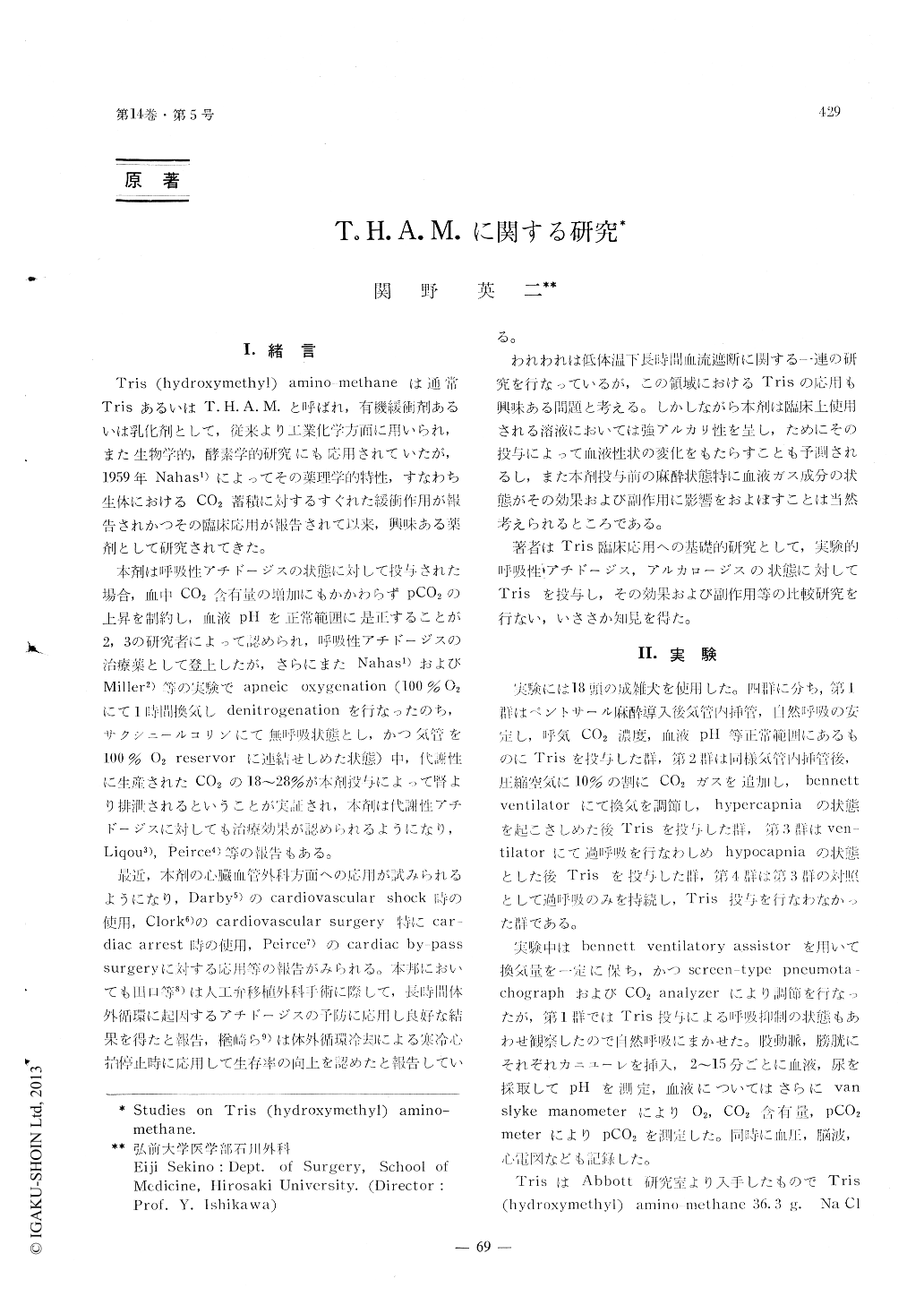Japanese
English
- 有料閲覧
- Abstract 文献概要
- 1ページ目 Look Inside
I.緒言
Tris(hydroxymethyl)amino-methaneは通常TrisあるいはT. H. A. M. と呼ばれ,有機緩衝剤あるいは乳化劑として,従来より工業化学方面に用いられ,また生物学的,酵素学的研究にも応用されていたが,1959年Nahas1)によってその薬理学的特性,すなわち生体におけるCO2蓄積に対するすぐれた緩衝作用が報告されかつその臨床応用が報告されて以来,興味ある薬剤として研究されてきた。
本剤は呼吸性アチドージスの状態に対して投与された場合,血中CO2含有量の増加にもかかわらずpCO2の上昇を制約し,血液pHを正常範囲に是正することが2,3の研究者によって認められ,呼吸性アチドージスの治療薬として登上したが,さらにまたNahas1)およびMiller2)等の実験でapneic oxygenation(100%O2にて1時間換気しdenitrogenationを行なったのち,サクシニールコリンにて無呼吸状態とし,かつ気管を100%02 reservorに連結せしめた状態)中,代謝性に生産されたCO2の18〜28%が本剤投与によって腎より排泄されるということが実証され,本剤は代謝性アチドージスに対しても治療効果が認められるようになり,Liqou3),Peirce4)等の報告もある。
Tris (hydroxymethyl) aminomethane for the buffering of CO2 in respiratory and metabolic acidosis has been evaluated with respect to its effect when used in the presence of high, low and normal CO2 balance.
In the dogs with normal acidbase balance, Tris itself is buffered by CO2 and the pH rises to low alkaline levels if it leaves the normal range. Tris given with low blood CO2 results in highly alkalotic pH values. In the presance of moderate respiratory acidosis, Tris brings the pH to or toward normal and tends to keep it there.
Blood CO2 content rises for each of the three sets of conditions where Tris was given. In respiratory acidosis the rise is precipitous, in normal CO2 balance the slower but definite increase is usually seen and when Tris is accompanied by the effects of; hyperventilation the CO2 content increase tends to be small. With continued hyperventilation only, the CO2 content gradually drops.
Expired alveolar CO2 concentration rises with increasing respiratory acidosis until the infused Tris concentration in the blood begins to take up the CO2. There is a gradual drop in expired CO2 in most cases when Tris is given with normal CO2 balance but this response is variable. The decreasing expired CO2 of hyperventilation may rise slightly or fall more gradually after Tris infusion is started.
Urine pH changes to alkaline values in all four sets of conditions. In respiratory acidcsis no urine samples were obtained, probably due to the oliguria secondary to hypercapnea. In normal CO2 balance and also when Tris is given following hyperventilation the urine becomes extremely alkaline, shortly after the infusion is begun. In all experiments where Tris was infused, a profuse diuresis was observed ten to fifteen minutes from the time the infusion was started. With hyperventilation only, the changes to alkaline urine values is late and more gradual.
Where spontaneous respiration was allowed, there was consistent and quite marked depression of respiration brought about by decreased rate of breathing. Tidal volume increased somewhat but not sufficiently to compensate for the depressed rate. Oxygenation of arterial blood was decreased from 3-5 percent.
The electrocardiograph recording showed quite consistent clamping of the T-wave during the more extreme hyperventilation and during Tris infusion following hyperventila lion and, in several dogs, there was actual inversion of the T-wave. However, this findings and the occational U-wave seen in several dogs, were no doubt a reflection of the alkalosis and to the Tris only where this agent exacerbated alkalosis.

Copyright © 1966, Igaku-Shoin Ltd. All rights reserved.


